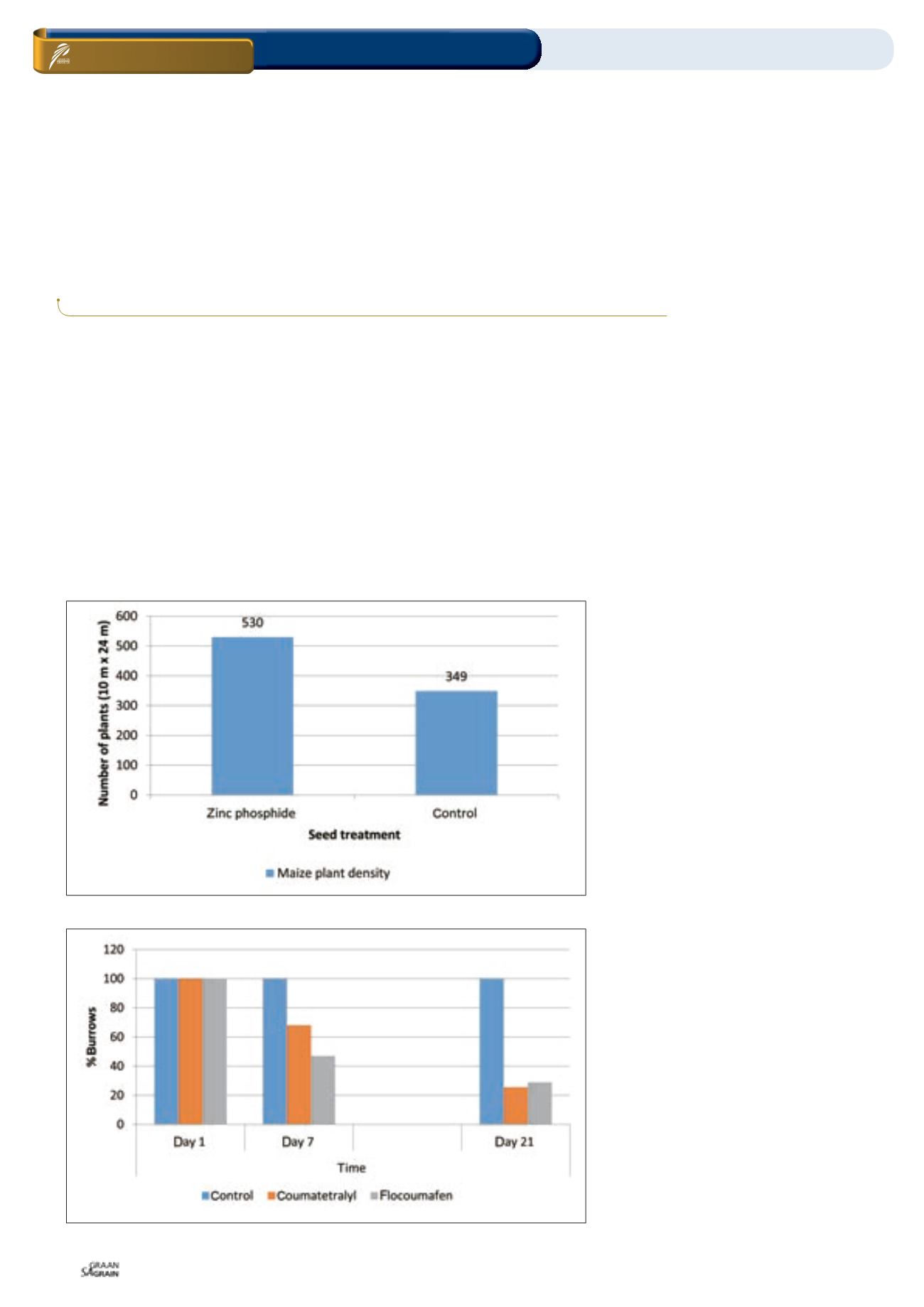
106
Updateongerbilmanagement
inmaize
A
project called “Ecologically-based
rodent pest management inmaize
crop fields in the summer rainfall
regions of South Africa”, funded
by the Maize Trust and the Agricultural
ResearchCouncil, startedat theendof 2013.
Field surveys and research trials were
conducted in the Hoopstad and Wessels-
bron areas of the Sandveld where severe
rodent damage to maize crops on sandy
soils in theNorthWest Free State had been
reported. Damage is usually restricted to
the crop planting stagewhen gerbils forage
on germinating maize seeds and newly
emergent seedlings.
The project actions consist of ecological
surveys; rodent species identification,
habitat utilisation, rodent breeding ecology,
and food utilisation, with a short term
objective of determining effective chemical
controlmethods.
Background
Two
Gerbilliscus
species (formerly
Tatera
)
are indigenous and common to central
SouthAfrica. Theyhave awidegeographical
distribution, from grassland to savannah
woodland, but prefer sandysoils irrespective
ofvegetation.TheBushveldgerbil (
Bosveldse
nagmuis, Gerbilliscus leucogaster
) occurs
from northern KwaZulu-Natal in the east, to
the Northern Cape in the west and further
north intoSouthernAfrica.
The Highveld gerbil (
Hoëveldse nagmuis,
G. brantsii
) occurs from the Eastern Cape,
thehighveldof theFreeState,Mpumalanga,
Gauteng and the North West Province, to
Limpopo, Botswana andNamibia.
Both these species were found in the study
area, but the Highveld gerbil (
Photo 1
) was
the species identified in the maize fields.
The two species are similar in diet and
habitat, but the Highveld gerbil tolerates
drier conditions than theBushveldgerbil.
They are nocturnal, eat seeds, herbage and
insects and do not hoard food. They dig
burrows, live in a loose social association in
colonies andmales have a home range area
of up to0,5ha. Theydonot climbanddonot
enter buildings.
A third species, the Cape gerbil (
Kaapse
nagmuis
,
G. afra
) is endemic to theWestern
Cape.
Chemical control trials
The effect of two types of chemical control
was tested as potential gerbil management
toolson commercialmaizeproducing farms
in the Hoopstad and Wesselsbron areas.
These were a seed treatment with a metal
phosphide at planting, and burrow baiting
with ready-bait rodenticides. Gerbil colony
size and activityweremonitoredbefore and
after applications of the chemicals in both
treated anduntreated sites.
Seed treatment
The effect of zinc phosphide treatment on
the germination of maize seed was tested
in the laboratory, with no significant dif-
ference in the germination and seedling
development between treated and untreat-
ed seed.
In the field, maize seed treated with zinc
phosphide was compared to untreated
maize seed. Plotsof 10mx24mweremark-
ed out around gerbil colonies. In the
untreated maize, gerbils dug up the ger-
minating maize seed around the colonies,
resulting inbarepatches, but inplotswhere
maize seed had been treated with zinc
phosphide, the incidence of gerbil damage
ON FARM LEVEL
Rodent pestmanagement /Maize /Habitat utilisation
Integratedpest control
EMIL VONMALTITZ, FRIKKIEKIRSTEN
and
PHANUELMALEBANA,
ARC-Plant ProtectionResearch Institute
Graph1:Maizeplant densityof zincphosphide treated seed compared tountreated seed (10mx24m).
Graph 2: Burrowbaitingwith two rodenticides in amaize field.
Oktober 2014


